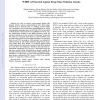Free Online Productivity Tools
i2Speak
i2Symbol
i2OCR
iTex2Img
iWeb2Print
iWeb2Shot
i2Type
iPdf2Split
iPdf2Merge
i2Bopomofo
i2Arabic
i2Style
i2Image
i2PDF
iLatex2Rtf
Sci2ools
FDTC
2009
Springer
2009
Springer
WDDL is Protected against Setup Time Violation Attacks
—In order to protect crypto-systems against side channel attacks various countermeasures have been implemented such as dual-rail logic or masking. Faults attacks are a powerful tool to break some implementations of robust cryptographic algorithms such as AES and DES. Various kind of fault attacks scenarios have been published. However, very few publications available in the public literature detail the practical realization of such attacks. In this paper we present the result of a practical fault attack on AES in WDDL and its comparison with its non-protected equivalent. The practical faults on an FPGA running an AES encryptor are realized by under-powering it and further exploited using Piret’s attack. The results show that WDDL is protected against setup violation attacks by construction because a faulty bit is replaced by a null bit in the ciphertext. Therefore, the fault leaks no exploitable information. We also give a theoretical model for the above results. Other references h...
| Added | 26 May 2010 |
| Updated | 26 May 2010 |
| Type | Conference |
| Year | 2009 |
| Where | FDTC |
| Authors | Nidhal Selmane, Shivam Bhasin, Sylvain Guilley, Tarik Graba, Jean-Luc Danger |
Comments (0)

